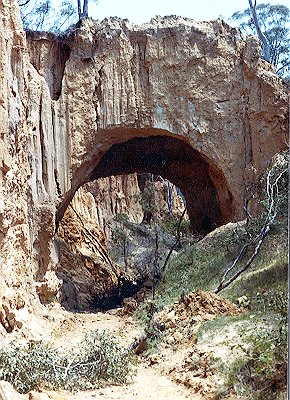Golden Gully and Archway facts for kids
Quick facts for kids Golden Gully and Archway |
|
|---|---|

The Grand Arch is approximately 5 metres (16 ft) in diameter
|
|
| Location | Golden Gully, Hill End, Bathurst Region, New South Wales, Australia |
| Official name: Golden Gully and Archway | |
| Type | state heritage (archaeological-terrestrial) |
| Designated | 2 April 1999 |
| Reference no. | 614 |
| Type | Alluvial Workings |
| Category | Mining and Mineral Processing |
| Builders | European and Chinese gold miners |
| Lua error in Module:Location_map at line 420: attempt to index field 'wikibase' (a nil value). | |
Golden Gully and Archway is a special place in Hill End, New South Wales, Australia. It used to be a very busy gold mining area, created by European and Chinese gold miners. Today, it's a protected heritage site, added to the New South Wales State Heritage Register on April 2, 1999.
Contents
A Golden Past
Golden Gully was shaped by European and Chinese miners in the 1800s. When the gold rush started in 1851, many people came looking for gold.
Miners dug deep holes called shafts. They also made tunnels called adits and drives to reach gold. They were looking for alluvial gold, which is gold found in riverbeds. This gold had settled on an old, buried riverbed.
Protecting the Site
In 1983, the National Parks and Wildlife Service wanted to protect Golden Gully. There were plans for new mining that could damage the site.
To keep it safe, a special order was put in place in 1987. This order helped protect the area. Then, on April 2, 1999, Golden Gully was officially added to the State Heritage Register. This means it is now a very important historical site.
What Golden Gully Looks Like
Golden Gully and Archway is a unique landscape. It looks like a deep, braided channel system. This system was created by the miners themselves.
The banks of the Gully have many shafts and drives. These show the different ways European and Chinese miners dug for gold. It's like an open-air museum of old mining methods.
A Changing Landscape
Over time, a lot of gold digging changed the land. The path of the Tambaroora Creek was moved and changed. Its bed was dug much lower than it was in 1851.
All this digging and natural erosion created amazing shapes. You can see spires, organ pipes, and arches in the rock. When you are inside the Gully, these structures seem to change color. They look different depending on the time of day and how the sunlight hits them.
Why Golden Gully is Important
Golden Gully and Archway is a major site from the Hill End-Tambaroora goldfield. It shows how much gold digging happened there. It also proves when the 1851 gold rush began.
The gully helps us see the differences in mining techniques. European and Chinese miners used different methods in the 1800s. The eroded gully clearly shows their unique shafts. European shafts were often square, while Chinese shafts were round. This makes Golden Gully a dramatic and special place.
Golden Gully and Archway was officially listed on the New South Wales State Heritage Register on April 2, 1999.

